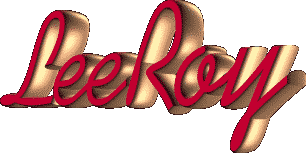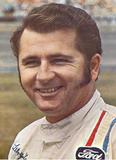
Click on a small image to see a full size image.
Famous 98

LeeRoy Yarbrough re-wrote the record book during the 1969 NASCAR Grand National season. He won 7 races -- all on superspeedways, setting a single season record for big track wins in a single season. Previously, the record had been 4 superspeedway wins in a single season set by Cale Yarborough in 1968. LeeRoy won both races at Daytona, both Darlington events, Charlotte's World 600, Atlanta's summer 500-miler and the autumn 500-miler at Rockingham. In 1969, LeeRoy Yarbrough's name sparkled like the biggest diamond at Tiffany's.

Final Days of #26

LeeRoy Yarbrough took over driving for Junior Johnson in 1967. The team was dogged by rotten luck through much of the 1968 season. Near mid-season, Johnson changed the number from #26 to #98 and their luck took a dramatic upswing, winning races at Trenton and Atlanta soon after the number was changed. Johnson applied his reasoning for abandoning the #26: "Any way you slice it, 26 is two 13s, and 13 is just bad luck."

Beefy '61 Ford

LeeRoy Yarbrough #99 and Paul Goldsmith #9 pair up on Daytona's high banks at the start of the 1967 Permatex 300 for NASCAR Late Model Sportsman cars. Yarbrough led the first 9 laps of the 300-mile contest, but early engine failure sent him to the sidelines. Yarbrough was driving a 1961 Modified Ford owned by Ernest Tufts. In those days, both Modified and Sportsman cars competed in the Saturday 300-miler at Daytona.

Four Wide at Daytona

Remember when cars could run 4-wide at Daytona? This dramatic photo shows Sam McQuagg leading in the #37 Dodge, with Jerry Grant in the blue Plymouth with the peeled left-front fender, Elmo Langley in the red Ford taking the bottom groove, LeeRoy Yarbrough in the white Ford, Charlie Glotzbach in the blue Plymouth to the high-side and Dr. Don Tarr's Chevy trailing behind. NASCAR racing was devoid of all the aerodynamical features you see today, and the racing was much more intense and wide open. It is a virtue that is probably gone forever and is sorely missed by those of us who were fortunate enough to witness racing from the muscle car era.

LeeRoy's Mercury

LeeRoy poses beside his Junior Johnson Mercury prior to the 1968 Daytona 500. Yarbrough led the 500 until the final 4 laps when Cale Yarborough made the decisive pass for victory. Note the "tower" at Daytona 30-some-odd years ago. A little control tower perched atop the aluminum roof above the Campbell Grandstand. The tower housed NASCAR officials, the Public Address announcer, Radio and Television crews.

LeeRoy's Indy Car

A versatile driver, LeeRoy Yarbrough drove virtually everything that had wheels, and quite effectively. He drove in 3 Indianapolis 500-mile classics and was also entered in the inaugural California 500 at Ontario Motor Speedway in 1970. Yarbrough was driving the Norris Industries IndyCar and very nearly won the race. Starting on the outside of the 3rd row, Yarbrough had no difficulty in handling the lightning high speeds or Ontario's tricky corners. He was leading with 9 laps remaining when the egine blew, relegating him to a 9th place finish.

Chevy Trio

General Motors and the Chevrolet nameplate took a back seat in NASCAR stock car racing during from 1964-1970, electing not to compete against the powerful Ford and Chrysler muscle car limited edition creations. When the factories retreated after the 1970 season, Chevrolet was able to make a comeback in NASCAR Winston Cup Grand National racing. Three potent Chevrolets were entered in the 1970 National 500 with LeeRoy Yarbrough #98, Charlie Glotzbach #3 and A.J. Foyt handling the driving chores. Yarbrough and Foyt ran into mechanical problems while Glotzbach finished 5th in the 500-miler.

'69 Ford Factory Team

Ford Motor Co. fielded a powerful factory team in 1969. Drivers (clockwise starting from the bottom) were David Pearson, Cale Yarborough, Richard Petty, LeeRoy Yarbrough and Donnie Allison. Pearson's #17 Holman-Moody Ford was used for this publicity shot. Fords won 15 of the 17 races stages on superspeedways and tracks over a mile in length. Back then, NASCAR did not really concern themselves with "leveling the playing field" like they do today. If a manufacturer came up with a better product, then they won the most races adn the rules were left alone. Ford's dominance in 1969 was directly responsible for the fabulous winged cars that Chrysler introduced in late 1969.
Skillful Speed Artist

LeeRoy Yarbrough, pictured here with team owner Junior Johnson, was a skillful navigator of NASCAR's speediest high-banked offerings. He took giant steps across the universe of speed, beckoned by the uncertainties that sparkled around the next corner. Sprinkled with liveral amounts of self-confidence, Yarbrough became a hardcore speed artist with active intelligence. He had an ability that carved a unique niche in the gallery of NASCAR greats.

100% RealRacer

Sprinkled with liberal amounts of self-confidence, LeeRoy Yarbrough became a hardcore speed artist with active intelligence. He had an ability that carved a unique niche in the gallery of NASCAR greats. He was two-thirds wildcat, one-third grizzly bear -- and 100 percent racer!



Sign My Guestbook
 View My Guestbook
View My Guestbook























